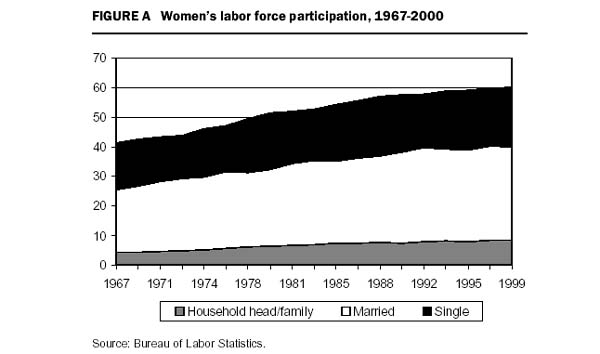 EPI Book | DECEMBER 2001
EPI Book | DECEMBER 2001
Shared Work – Valued Care
New norms for organizing market work and unpaid care work
Eileen Appelbaum, Thomas Bailey, Peter Berg, and Arne L. Kalleberg
This book’s executive summary and introduction are also available in Adobe Acrobat PDF format ![]()
Executive Summary
For a century or more, until the mid-1970s, the husband-as-breadwinner and wife-as-homemaker system governed social attitudes and individual aspirations toward paid work and unpaid care in the United States. Women’s participation in paid employment rose steadily during much of that period, as rising educational levels, paid employment during wars, the growth of the service sector, and the emergence of the caring professions encouraged women to move outside the domestic sphere. However, most married women still left paid employment and became full-time homemakers when their children were born.
Since the mid-1970s, the rapid increase in the paid employment of mothers has made the traditional breadwinner–homemaker system of paid work and unpaid care untenable. It has been supplanted by the “ideal worker–marginalized caregiver” model of work and care in which all workers – male or female – can hold a full-time job provided they conform at work to employers’ notions of a worker unencumbered by domestic responsibilities. This model of organizing paid and unpaid work has left most American working families anxious about their ability to care adequately for their children and aging relatives, stressed by the demands of work, and starved for time. Moreover, women who pursue homemaking on a full-time basis are dismissed as “just housewives,” and the important care work they do is devalued. This attitude has been taken to an extreme in the case of poor single mothers. The emphasis in the recent “reform” of welfare in the U.S on “work first” over “care first” has placed a greater value on having a woman work at minimum wage cleaning hotel rooms than on having her care for her child – even though her earnings will still leave her and her children impoverished.
This study examines practices in Japan, Australia, Sweden, Germany, the Netherlands, and Italy to gain insights into how work and care responsibilitie might realistically be reorganized to better meet the needs of working families. It is based on interviews with government officials, academics, managers, employees and representatives of unions and employers’ associations conducted from June to November 2000.
What emerged from this review of practices abroad was the possibility for a new set of social norms that structure behavior by tempering employers’ demands and shaping the aspirations of workers. Such a model of behavior can be characterized as “shared work–valued care.”
“Shared work” encompasses a combination of work with other aspects of well-being. It means sharing paid work among people through shorter work weeks, reduced hours, flexible schedules, and job sharing. It refers to sharing access to good blue- and white-collar jobs with mothers. It recognizes that equal access to paid jobs for women requires that men as well aswomen share in the important work of providing care within the family and community. Finally, it involves sharing the work of caring with community and other public institutions.
“Valued care” means that employees have access to a variety of flexible scheduling strategies so they can take greater control of their time and can negotiate the flexibility they need to meet their individual responsibilities. It also involves the sharing of day care and elder care as public-private responsibilities. In this way, families can have access to high-quality services, while workers who care for the young, the old, the sick, and the infirm can have access to good-paying jobs.
An important lesson from examining practices in other countries is that public policy has an indispensable role to play in helping nations achieve the norms of shared work–valued care. The policies needed to facilitate a system of shared work and valued care in the U.S. include:
-
Hours-of-work legislation to allow for a shorter standard work week for all, flexibility for workers, longer part-time hours, and limits on mandatory overtime.
-
Adjustment-of-hours legislation to allow workers to request up to a 20% reduction in hours and pro-rated reductions in pay and benefits.
-
Equal opportunity and non-discrimination provisions to protect workers on part-time schedules from discrimination in pay or benefits.
-
Sharing of the cost of care by investing in day care and elder care infrastructure, and by providing subsidies for child care and elder care, short-term carers’ leave, subsidized wages or tax credits for caregivers, universal preschool, and after- and before-school programs for children.
-
Untying of benefits from individual employers by making access to health insurance available to everyone without regard to employment status, and by establishing funds similar to unemployment insurance
for maternity leave, parental leave, and long-term family medical leave. -
Updating of income security protections such as unemployment insurance and old age pensions to reflect the changes and great variety in family structure and in work arrangements.
Introduction
Much of the stress and anxiety facing working families in the U.S. arises from recent rapid changes in the paid employment of women, especially mothers, without compensating changes in the norms and institutions that support paid market work and unpaid care work. In 1967, 41.2% of women over the age of 20 were in paid employment. By 1999, that proportion had increased to 60.1% (see Figure A). Among married women, the increase has been even more dramatic. Between 1967 and 1999, the labor force participation of married women increased from 36.6% to 62.0%. In more than 60% of all married-couple households, both spouses are employed.
Over this period, women’s employment in the U.S. increased most rapidly among married women with children. By 1999, nearly two-thirds of married women with children under the age of 6 were in the workforce, as were nearly three-quarters of those with school-age children (6 to 17). Largely as a result of these employment increases, average annual hours worked per year by married-couple households have grown explosively. In 1979, middle-class couples with children worked 3,272 hours a year on average – a little more than one full-time and one part-time job. In 1998, these families worked, on average, 3,885 hours a year – equivalent to nearly two full-time jobs.
Despite the increase in the percentage of women in the U.S. labor force, social supp
orts for work remain largely unchanged since the 1930s. In the U.S., unemployment insurance and Social Security laws were written to protect families dependent on the wage of a male breadwinner. Not until 1993 did women have the legal right to take time off from work at the birth of a child. But maternity leave is unpaid, limited to 12 weeks, and unavailable to the large numbers of women who work in establishments that employ fewer than 50 workers. In contrast to most other industrialized countries, workers in the U.S. have no rights to paid vacation leave, sick leave, or parental leave. Mandatory overtime is common, and there is no national legal maximum number of hours of work in a day or a week.

To gain insights into how work and care responsibilities in the U.S. might realistically be organized to better meet the needs of working families, we conducted a study tour of Japan, Australia, Sweden, Germany, the Netherlands, and Italy during June to November 2000. We met with government officials, academics, and representatives of unions and employers’ associations. We also visited firms in these countries, and conducted interviews with managers and focus groups with employees to get a company perspective on this question. These interviews focused on white-collar professionals, nurses, and blue-collar workers.
What our research team has begun to distill from our study tours abroad is a new model of organizing paid market work and unpaid care in the home. We characterize this model as “shared work–valued care.” While no
country can serve as a model in every respect, we found there was much that each country we studied can learn from the others. Much of the learning is already underway in Europe, with impetus from the European Union for harmonization. The influence of the Treaty of Amsterdam and associated directives adopted at the Luxembourg and Vienna summits between 1997 and 1999 on equal opportunity, “gender mainstreaming,” equal treatment of part-time workers, and earned paid time off or “working time” accounts has been especially positive.1 Nevertheless, the model of shared work and valued care cannot be said to exist in any of the countries that we visited. Elements of it can be observed in many places, however, and its broad outlines are clearly discernible.
The first section of this study describes the “unencumbered worker–devalued caregiver” model2 that has come to characterize work and care responsibilities in the U.S. over the last three decades. As women have increased their participation in paid employment, the notion of the employee as male breadwinner has given way. It has been replaced by the notion that employers are entitled to an “unencumbered worker” – an employee, man or woman, who functions in the workplace as if he or she has a wife or other caregiver at home full time. In the course of this change, unpaid family care work has been devalued, and caregivers have been marginalized.
The second section describes the system of shared work–valued care that we think could go a long way toward resolving the unbearable tensions and forced choices American working families currently face. This section draws on our observations in the six countries in our study, and our interviews with managers in companies in these countries, to begin to imagine what such a system of norms might look like.
The paper concludes with a set of policies,3 many of them already in place in one or another of the countries we studied, that would facilitate the emergence of gender-neutral norms of shared work and valued care in the United States.
Endnotes
1. The Treaty of Amsterdam was proposed in 1997 and identifies employment as an area of common concern for the EU. It calls for the drawing up of “national action plans.” The Luxembourg summit in 1997 established guidelines for the national action plans that include equal opportunities for women as well as employability, entrepreneurship, and adaptability as important components. The Vienna summit in December 1998 established gender mainstreaming as a new guideline and required gender issues to be considered in all four aspects of the national action plans on employment, not just as part of equal opportunity. The Lisbon summit in 2000 recognized the importance of child care in achieving the employment goals of the Treaty of Amsterdam. (For a fuller discussion, see J. Rubery, M. Smith, et al. 2001.) As a result, it is mandatory for EU countries to take equal opportunity policy and the mainstreaming of women into account in designing employment policies. It is no longer acceptable to marginalize women in the labor market and restrict them to certain industries and occupations. The treaty and related directives provide a legal basis for women to challenge their second-class status in the European Court of Justice. As a result, the Italian government, for example, is examining the situation of women in each region. However, the treaty and related directives have not yet been translated into law, and their implementation in Italy and elsewhere in the EU may take years.
2. See also Williams (2000) on this point.
3. These policies were initially suggested, as they are presented here, by Randy Albelda during a meeting of the Sloan Foundation-sponsored Work and Family Research Network
